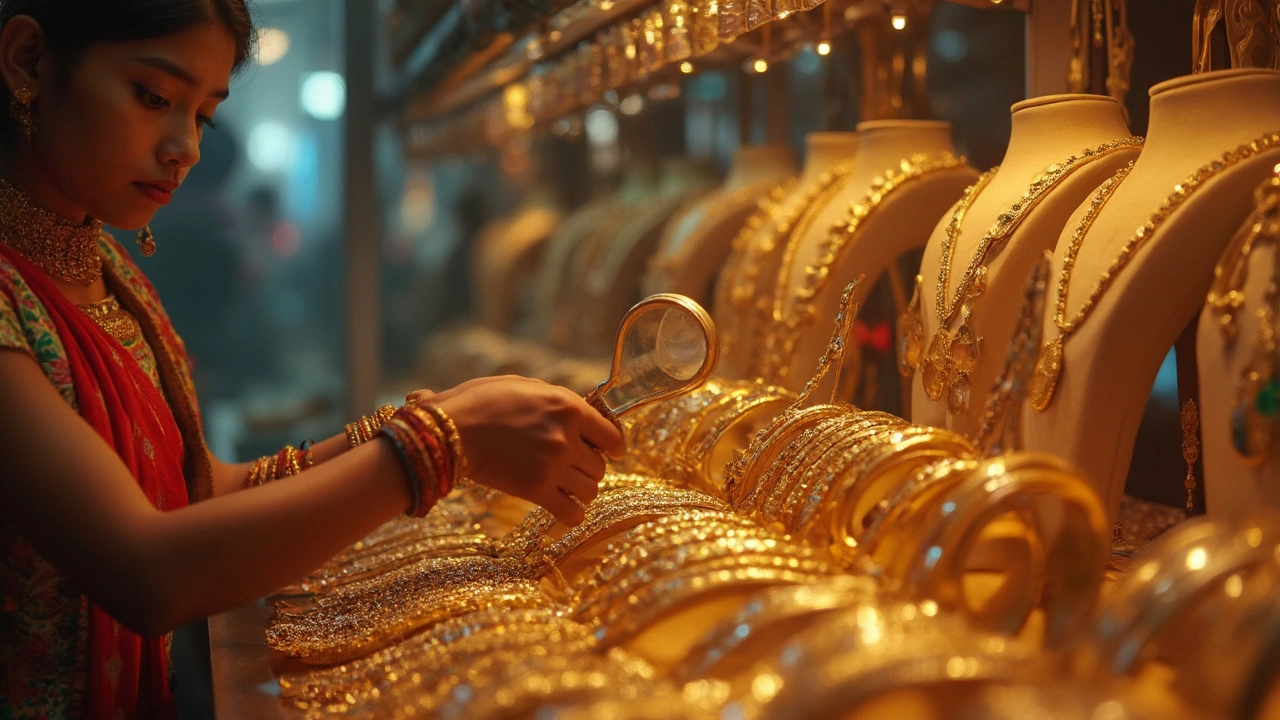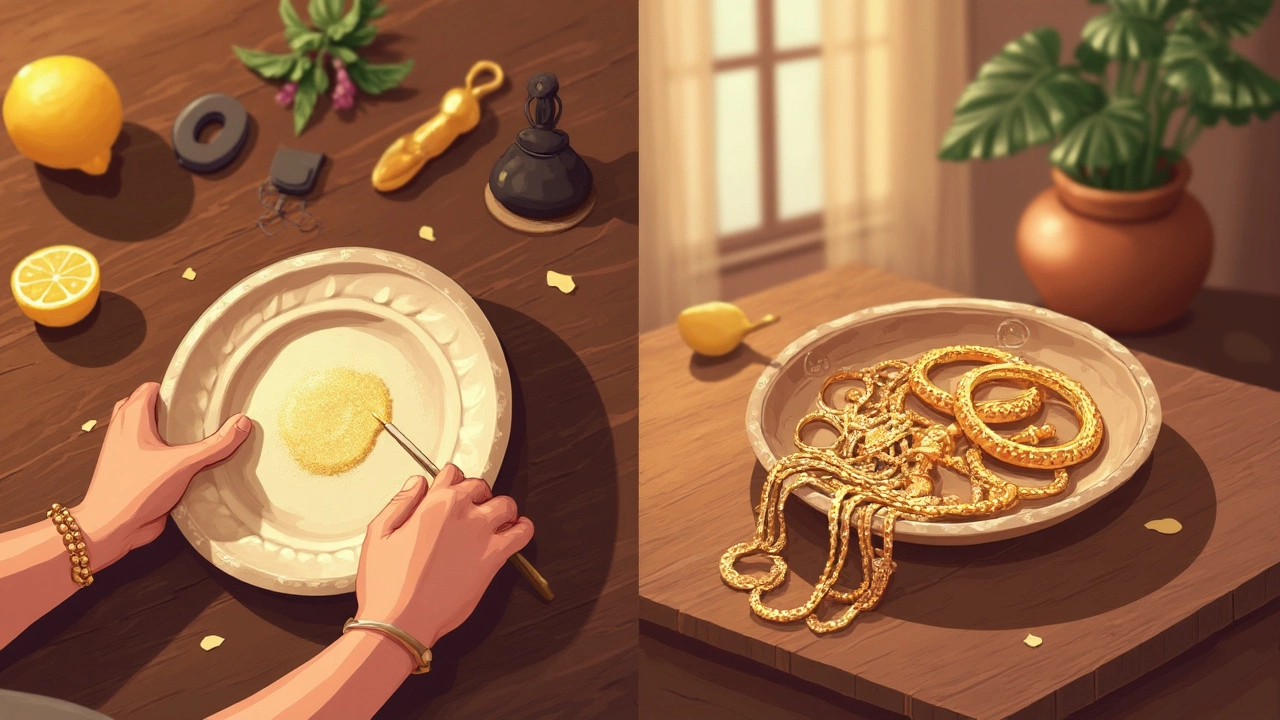
Ever picked up a gold chain that looked amazing online, but in person, it felt kind of... underwhelming? You're not alone. Cheap jewelry is everywhere, and sometimes it looks almost as good as the real thing—until you know where to look.
Here’s the thing: real gold isn’t just about the shine. There are a bunch of little clues that most people miss. For starters, if your skin turns green or itches after wearing it for a day, that’s a big red flag. Cheap metals often react with sweat or lotions, leaving a not-so-cute stain behind.
Another quick tip: check the weight. Gold is heavy for its size. If that chunky bracelet feels lighter than a pencil, it’s probably not legit. Got a magnet nearby? Real gold won’t stick. If it does, you’re holding something else, maybe brass or stainless steel with a gold wash.
- Quick Ways to Check If It's Real Gold
- Quality Clues: Hold, Weight, and Shine
- Secret Hallmarks and Stamps Explained
- Common Traps: What Fake Jewelry Sellers Do
Quick Ways to Check If It's Real Gold
Before you drop cash on that new piece, check if it’s actually gold or just trying to look like it. You don’t need a lab. You just need a few simple tricks and a sharp eye. Here are the big ones that work, even at home:
- Look for stamps. Real gold is almost always marked with stamps like 10K, 14K, 18K, 22K, or 24K. If you spot GP (gold-plated), GF (gold-filled), or GEP (gold electroplated), it's not solid gold. Grab a magnifying glass—these stamps can be tiny.
- Test with a magnet. Gold won’t stick to magnets, but most fake versions will. Use any regular fridge magnet to see if your jewelry is attracted. No pull? That’s a good sign.
- Try the float test. Drop the jewelry in a cup of water. Real gold sinks because it's dense. If it floats or just hovers, you're probably looking at something else.
- Check the smell. Weird, but true. Rub the gold on your palm for a minute. If it leaves a metallic smell, it could be fake—real gold doesn’t have an odor.
- Scratch test (gently!). If there’s a hidden spot, scratch lightly with an unglazed ceramic plate. Fake gold will leave a green or black streak. Real gold shows a gold streak, if any.
Let’s drop some quick numbers about gold purity for perspective:
| Stamp | Gold Content |
|---|---|
| 24K | 99.9% pure gold |
| 22K | 91.7% pure gold |
| 18K | 75% pure gold |
| 14K | 58.3% pure gold |
| 10K | 41.7% pure gold (USA minimum for 'gold' label) |
If you want to be extra sure and it’s worth it (like with a pricey ring), you can buy an acid gold testing kit online for about $10. But for most day-to-day checks, these fast tips will help keep you from getting burned by cheap jewelry. Remember, legitimate gold jewelry holds its value—and it doesn’t feel flimsy, fake, or leave your skin looking weird.
Quality Clues: Hold, Weight, and Shine
Alright, let’s get hands-on. When you’re checking out jewelry, grab it and really feel it. Real gold jewelry—especially solid pieces—packs some heft. Compare a real gold ring and a fake one: the fake always feels oddly light, almost plastic. That’s because gold is a dense metal, way heavier ounce-for-ounce than lookalikes like brass or aluminum.
Now look close at the shine. Gold jewelry has this soft, deep glow—not too bright, not too flat. Cheap jewelry often tries to play catch up, but you’ll notice it’s either way too shiny (like it's coated in a thin fake gloss) or dulls after a bit of handling. If you rub it with your finger and the sparkle comes off, it’s just gold plating.
Touch the edges and details, too. Well-made gold pieces feel smooth even in the tiny spots. Cheaper items might scratch your skin or show rough finishes, especially on clasps or chain links. Those flaws might not sound huge, but they’re classic signs of corners being cut.
Here’s a rapid-fire checklist:
- Weight: Solid gold feels heavier than it looks.
- Shine: Real gold glows, fakes either blind you or fade fast.
- Surface: Edges and backs should be smooth, no gritty or flaky bits.
- Feel: No weird tingling or metallic taste on your skin after wearing it awhile.
The next time you pick up a piece that looks too perfect but feels off, trust your instincts. Fakes are built to trick your eyes, but they never fool your hands for long.

Secret Hallmarks and Stamps Explained
If you want to weed out cheap jewelry fast, always check for hallmarks and stamps. These tiny engravings tell you if you’ve got the real deal or just something pretending to be gold. Real gold pieces almost always have a mark somewhere—usually on the clasp, the inside of a ring, or the back of a pendant.
For gold in the US, look for numbers like “14K,” “18K,” or “24K.” That “K” stands for karat, a quick way to show how pure the gold is. “925” means sterling silver, not gold, but it’s good info to know. On pieces from Europe, you might see numbers like “585” (that’s 14K) or “750” (that’s 18K) instead of the “K” mark.
- If your jewelry says “GP,” “GF,” or “GEP,” watch out. That means it’s gold-plated, gold-filled, or gold-electroplated—not solid gold.
- Fake pieces sometimes use random stamps that look official but don’t match up. If the numbers look oddly spaced, blurry, or painted on, it’s a bad sign.
- Some countries require maker’s marks or symbols from the manufacturer. Seeing one doesn’t mean it’s real, but no mark at all is a big warning.
Don’t forget, these marks are small. Take a close look with good lighting or even a magnifying glass if you have one. If the stamp is missing entirely, peel up your antenna—real gold almost always comes with a stamp unless it’s super old or has been resized.
As the Gemological Institute of America puts it,
“Authentic jewelry is typically stamped with its metal content and, often, a maker’s or designer’s mark.”Knowing what these stamps mean saves you from guessing or getting ripped off.
Common Traps: What Fake Jewelry Sellers Do
Some fake jewelry sellers are pros at making their goods look legit, especially when it comes to cheap jewelry. They know all the tricks to make fakes pass for real gold at first glance. Knowing what these traps look like will save you from expensive mistakes.
One big trap is fake hallmarks. Scammers stamp random numbers like “18K” or “750” on jewelry, but if you really look, the stamps are sometimes crooked, shallow, or missing altogether. Real marks are clean and consistent, even on tiny parts like clasps or the insides of rings. If you see a hallmark in an odd spot or the font looks sketchy, be careful.
Another classic move: gold plating on top of cheap metals. Sellers will call their stuff “gold-filled” or use confusing terms like “vermeil.” Plated jewelry can look shiny but after a few wears, the gold rubs off and you’re left with dull, weird-looking metal underneath. If the price seems too good to be true for a piece that looks big and flashy, it’s probably just plated.
Watch out for photoshopped images in online shops. Stock pictures or overly edited photos hide flaws, so look for real-life pics with close-ups. If you can't see shots of the actual item or reviews don’t show genuine photos from buyers, that’s a bad sign.
Sometimes, shady sellers push “certificate of authenticity” cards. These can be totally fake and aren’t worth anything unless they come from a legit, trusted lab—think GIA or IGI, not some random shop name printed on cheap paper.
- Ask direct questions: What is the base metal underneath? Is it solid gold or plated?
- Research the seller’s return policy before buying. If they make refunds hard, you’re probably not getting anything valuable.
- Look up the seller’s ratings and feedback outside of their own website. Real customers will call out scams fast.
Last thing—if they rush you with limited-time offers or pressure you for quick payment via shady methods like wire transfer, step back. That’s a classic sign of a con.






